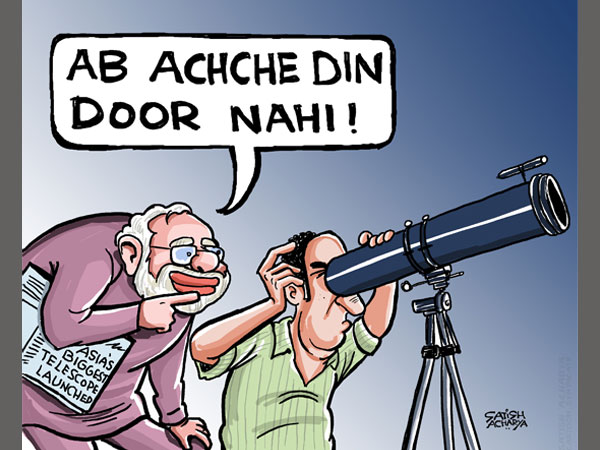There are strong chances that the central government, desperate to retain control of its flagging popularity post demonetisation, will try to make this announcement in its budgetary speech in the pre-poned budget session of parliament in January 31. The moot question is, will the Election Commission allow this just before major elections in five states, when it appears to be a clever policy measure to ‘woo” voters disillusioned with demonetisation?

Cartoon: Satish Achrya
Reports coming in suggest that the Indian government to endorse universal basic income 'as way forward', says a leading UBI advocate. India, the world’s largest democracy, with high poverty figures, will release after the Economic Survey of India report is released in January, conclude that the UBI is “basically the way forward,” according to Professor Guy Standing, who has worked on universal income pilot projects in India. This has been reported by the UK-based Independent. If implemented, India would join Finland in providing free money to citizens.
There are doubts whether, the government will truly make this a universal scheme to benefit 42 per cent of India’s population or cleverly limit it to a small section of the population. It could however, at budget announcement time make it seem that it is for all the poor. Modi has been a successful spin doctor of promises unfulfilled.
Under a universal income system, citizens would receive a set amount of money from the state, forfeiting all other benefits. India, which has an estimated population of 1.3 billion people, has a growing economy but, according to real estimates, is close to 42 per cent of India’s total population. The Tendulkar committee, that arrived at these figures after being set up by the UPA in 2005, had controversially suggested a family earning Rs 33 per day in a city and Rs 27 on a daily basis in rural areas, should be termed as poor. This panel was formed to review the methodology for estimation of poverty. It estimated the extent of poverty using a poverty line defined in terms of monthly per capita consumption expenditure. Based on this formula, the erstwhile Planning Commission arrived at a poverty line and poverty ratio.
Corporate honchos and economists pushing the neo-liberal framework have been trying their best to reduce these statistics to sat that only about 29.5 per cent of Indian people live in poverty.
India’s Chief Economic Advisor, Arvind Subramanian, has stated in the months before demoentisation that annual Economic Survey due on January 31, 2017 would discuss UBI.
Subramanian has been quoting as saying that “this is an idea that has a lot of promise, but also challenges. It will be an extension of JAM (Jan Dhan, Aadhar, Mobile Money) in that it will be based on cash transfers.” What the CEA is saying is that universal basic income is essentially a form of cash transfer. It doesn’t matter what you name it, but it is an alternative to providing subsidies in kind, are subject to leakages and corruption. In the Indian version of UBI, basic income may be a migration of subsidies to cash in the first instance. Between major subsidies and payments for the MGNREGA employment guarantee scheme, the government spends nearly Rs 3,00,000 crore per annum – roughly two percent of GDP.
Welfare State or Cashless Doles
Proponents of the welfare state have been opposed to cash (or cashless transfers) as they do not in any way really meet targets of either tackling nutrition or health standards, besides absolving the state of actually improving public health and education facilities.
Others opposing UBI while not opposing some share of income with the poor, do not extend this to the mandatory commitment and responsibility the state ensuring health and education resources. This view posits the debate between efficient cash transfers and an inefficient subsidy regime.
How do we finance UBI?
This hardened economic view that wants to cut other government ‘subsidies’ argues that at a ceiling of two percent of GDP on central subsidies, in 2016-17 some Rs 3,00,000 crore will be available for cash transfers. Assuming around 25 crore households (there is a similar number of Jan Dhan accounts) in the country, this money is enough to deliver an annual income of Rs 12,000 per household, or Rs 1,000 per month.
The government’s Economic Survey for 2014-15 estimates that subsidies for the following items amount to 4.2 percent of GDP (Gross Domestic Product): cereals, pulses, sugar, oil-related products, iron ore, fertilisers, electricity, water, and rail services. If the ceiling limit is increased to say four percent of GDP, every household will get Rs 2,000 per month. And then if the government privileges one section of the poor –and does not follow the universal benefit route– the figure rises to Rs 4,000 per month.
While for Narendra Modi, in his oft-touted broken promise that said he would return Rs 15 lakhs to every Indian (when he tracked illegal stashed money) the reduced 4,000 would be a pathetic alternative. But for a pathetic spin doctor, unsure of how demonetisation will be viewed by the voter, this may be a desperately needed step.
If Modi wants to emerge as the greatest messiah of poor, to save himself and his party before the state polls that are due, this may be his best bet.
But will the Election Commission allow and permit this just before the polls when the restrictions against ‘buying the voters’ are in place?
